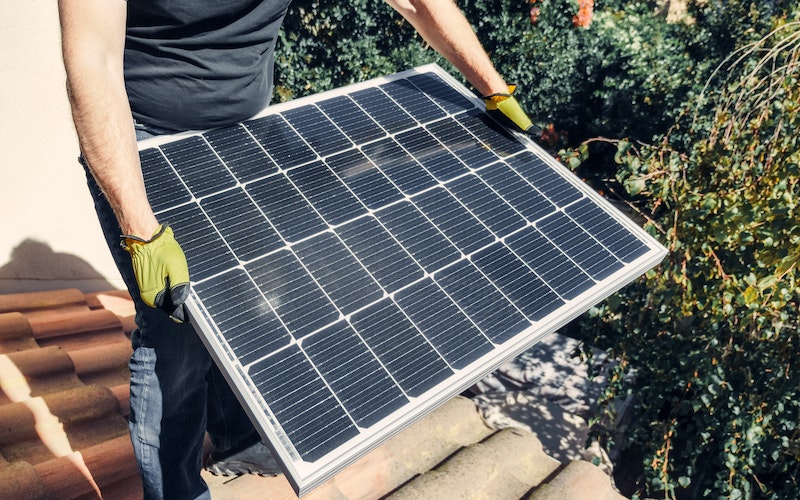It’s a wonder humanity isn’t powered 100% by alternative energy technologies with just how many innovations there are. The green energy sector is booming, driven by demand and falling prices. It’s causing companies to think even bigger and more imaginatively to find creative solutions to power the world through a green lens.
So, what are the contenders for the most game-changing technologies as humans enter another year of the sustainability journey?
1. Solar Panel Innovations
Everyone knows solar panels are the way of the future, but they’re on this list for a reason – because they can’t be stopped when it comes to making them even better than before. Engineers always discover ways to make them more resilient against weather and more efficient to construct. Here are some of the most hyped solar panel innovations you may have missed.
When imagining solar panels, they’re on grassy plains or roofs – but what about floating on water? Meet floatovoltaics. This exciting advancement has become a reality through analyses of whether the panels affect aquatic life and overcoming issues of grounding them and cable management. The best of the best figured it out, allowing humans to create more multipurpose spaces for energy collection – plus, it’s cheaper.
Humans have also moved to a phase of solar panel development where panels are directly integrated with building design. Building-integrated photovoltaics are malleable, sliding into facades with thin-film or crystalline panels.
Assuming sun-blocking trees don’t surround the building, the panels could save considerable money and even provide some thermal insulation. Especially if you choose to put a solar skin on it – another cosmetic improvement coming into the sector – you don’t have to sacrifice aesthetics for that green mindset.
2. Carbon Capture and Storage (CCS)
CCS has been contentious in the alternative energy technology landscape because of a lack of policy support and gaps in efficiency. Thankfully, both of these areas are seeing much-needed improvements.
Those practicing carbon capture often need to incorporate other farming or manufacturing techniques to supplement its effectiveness and reduce its energy intensiveness. For example, carbon capture can remove carbon dioxide from the atmosphere, but what about ash emitted from plants? Therefore, it can’t be the only implemented technology.
However, advancements in CCS are helping to increase its value. One way is increasing its effectiveness at separating carbon dioxide from flue gas by reducing costs and frustration. The sector is testing multiple innovations, including a mixed salt process that can use less energy by operating at room temperature but still capture more carbon dioxide than traditional means.
3. Green Hydrogen Electrolyzers
Onshore and offshore versions of green hydrogen electrolyzers are now available. This is a necessary advancement in hydrogen production when most of the world’s produced hydrogen is “grey” – that is, created using fossil fuels like natural gas. Other types of hydrogen, including “blue” hydrogen – created from CCS – are more environmentally friendly forms. However, “green” hydrogen is ideal because it is the most sustainable.
Electrolyzers separate water into hydrogen and oxygen. They are a great alternative energy technology because wind turbines or other renewables power them, making them a net-zero option for helping create energy. Though this is a recent advancement, offshore green hydrogen electrolyzers could change the sector, especially as further innovations continue to reduce manufacturing and operations costs.
4. Power-to-X
This alternative energy technology sounds like it’s pulled from science fiction, but it’s real. It’s an overarching term referring to advancements in electricity conversion, turning it into heat or synthetic fuels. Combine this with renewable energy, and humans have discovered something remarkable. Imagine creating green natural gas – that’s what this technology can do.
One of the unique ways power-to-X energies can help is by not requiring a lot of additional infrastructure. Manufacturing plants don’t have to overhaul fuel systems if e-fuels work in their place. This reduces unnecessary energy and resource consumption while other green technologies and alternative energy plants can be installed to power renewables.
5. Internet of Things (IoT)
Though IoT isn’t necessarily a green technology, it powers renewable growth with all the data it offers. IoT-connected devices like thermostats allow the built environment to adjust to outside temperatures without human influence.
IoT devices collect millions of data points. With machine learning, they help humans understand the gaps in our current renewable energy research. Some say IoT is essential for the world to achieve the United Nations’ sustainable development goals on time.
Especially since humans are becoming more reliant on technology every day, digital waste keeps increasing. Humanity needs IoT to help curb the rising demand, and nothing works faster than the power combo of IoT and artificial intelligence (AI).
6. Electric Vehicle (EV) Advancements
The sustainability conversation cannot ignore EVs, especially when lithium-ion batteries are the most controversial aspect of arguably one of the most sustainable forms of individual transport on the planet. Companies are testing more sustainable recycling methods alongside trying to find improvements for manufacturing efficiencies.
Though EV batteries last longer than some buyers anticipate, recycling isn’t happening as frequently due to the hazards and high costs. Existing battery recyclers already have the infrastructure – but only in a few places worldwide, like China.
Therefore, shipping becomes expensive and potentially counterproductive when considering the environmental impact. Initiatives to build more local infrastructure, instill more widespread governmental policies, and create a more significant case for recycling will change the landscape next year.
7. Energy Storage
To store excess energy to help balance demand and production, humans must find ways to keep and distribute renewable energy to the masses if energy generation becomes inconsistent. This includes innovations like pumped hydro, which can automate energy release based on spikes in usage.
This is one technology humans must perfect for long-term sustainability. Energy storage could work with IoT to gather analytics on countless optimizations, including how much extra storage it should allocate for winter months.
Better Alternative Energy Technology for 2023
On top of all these incredible demonstrations of ingenuity, still more technologies are coming of age to support renewable growth. From small to grand scales, humans are finding truly innovative ways to power the world – like microbes in biomass energy or putting solar panels on the moon. The determination of the species will ramp up renewable growth in 2023 and for many years to come.










